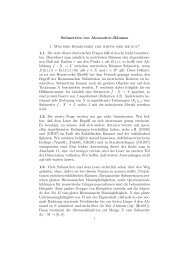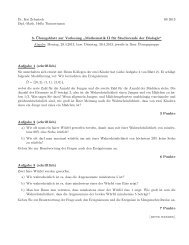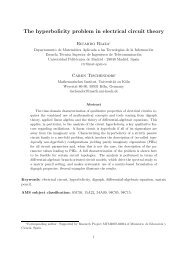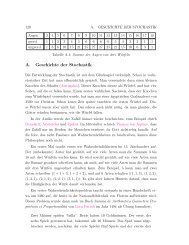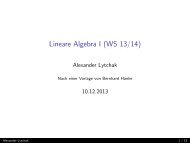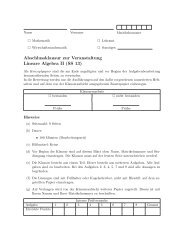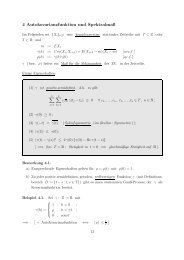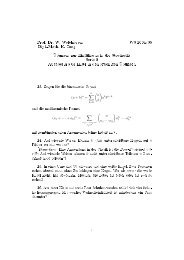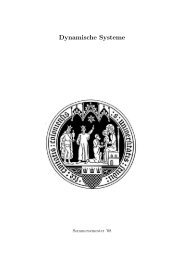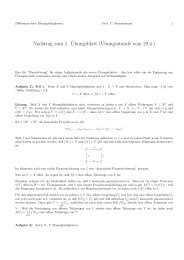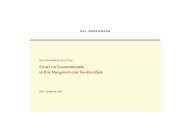Inhaltsverzeichnis - Mathematisches Institut der Universität zu Köln
Inhaltsverzeichnis - Mathematisches Institut der Universität zu Köln
Inhaltsverzeichnis - Mathematisches Institut der Universität zu Köln
Create successful ePaper yourself
Turn your PDF publications into a flip-book with our unique Google optimized e-Paper software.
DMV Tagung 2011 - <strong>Köln</strong>, 19. - 22. September<br />
Christine Bessenrodt<br />
Leibniz <strong>Universität</strong> Hannover<br />
Kronecker products of characters of the symmetric groups with few components<br />
One of the central open problems in the character theory of the symmetric groups is the problem of<br />
decomposing the Kronecker products of their characters into irreducible characters. As James and Kerber<br />
remark in their book The representation theory of the symmetric group, a product of irreducible characters<br />
of Sn is “in general reducible”. Jointly with Kleshchev, we have shown in 1999 that such a product is even<br />
only homogeneous in the (trivial) case of multiplying with a character of degree 1; we have also classified<br />
products with two homogeneous components for determining the homogeneous character products for<br />
the alternating groups. Furthermore, we conjectured in 1999 a classification of products with at most four<br />
homogeneous components. This conjecture has now been verified; on the way towards this result new<br />
information on constituents in Kronecker products has been obtained.<br />
Literatur<br />
Bessenrodt, C. and A. Kleshchev (1999). On Kronecker products of complex representations of the symmetric<br />
and alternating groups. Pacific J. Math. 190, 201 - 223.<br />
Bessenrodt, C. and S. van Willigenburg (2011). On Kronecker products of characters of the symmetric<br />
groups with few components, arXiv:1105.3170<br />
Michael Cuntz<br />
<strong>Universität</strong> Kaiserslautern<br />
From Hopf algebras to toric varieties via the Weyl groupoid<br />
In the classification of finite dimensional Nichols algebras of diagonal type, the so-called Weyl groupoids<br />
played an important role. Meanwhile, the finite Weyl groupoids have been thoroughly investigated,<br />
including a complete classification. It turns out that they correspond to simplicial arrangements satisfying<br />
a certain integrality axiom. This integrality translates to the smoothness of the toric varieties associated<br />
to the corresponding fans.<br />
Susanne Danz<br />
University of Oxford<br />
On the double Burnside ring of a finite group<br />
In recent years, the double Burnside ring B(G,G) of a finite group G has proved to have important<br />
connections with modular representation theory of finite groups, with topology, and with the theory of<br />
fusion systems on finite p-groups. For these and other applications, one needs to carry out explicit<br />
computations in the ring B(G,G), in or<strong>der</strong> to determine certain units or idempotents. However, the<br />
multiplicative structure of B(G,G) is, in general, non-commutative and rather involved. In this talk I will<br />
focus on distinguished subrings of the double Burnside ring B(G,G), and present a candidate for a<br />
non-commutative analogue of the well-known mark homomorphism of the commutative Burnside ring.<br />
This homomorphism translates the complicated multiplication rule of these subrings into a much more<br />
transparent one. If time permits, I will also outline some applications to the theory of fusion systems. This<br />
is joint work with Robert Boltje.<br />
11




